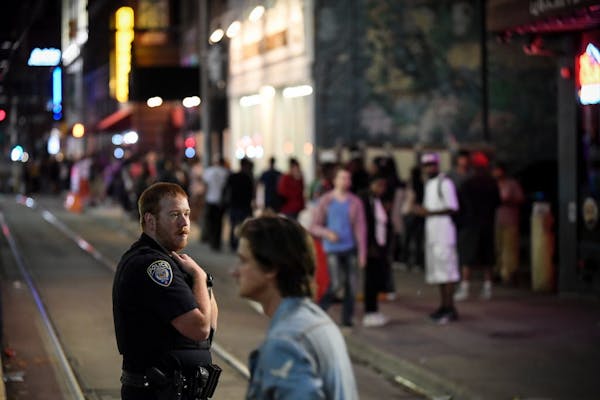Minneapolis police have been trying to get innovative in tackling the stubborn crime problem downtown.
New fencing along the light rail line was installed to discourage thieves from preying on people waiting for the train at the Warehouse District platform. There are new streetlamps and security cameras. And workers removed electrical sockets along Nicollet Mall that had become busy phone-charging stations that drew unruly behavior.
The changes have paid off so far in 2018, probably aided by the cold weather and intense extra Super Bowl security.
In the first 2½ months of 2018, violent crime has decreased by a third compared to the same period in 2017, with 98 reported incidents this year. The most dramatic decrease was for robberies, which tumbled from 71 to 26, according to newly released department statistics. Serious assaults, such as shootings and stabbings, crept up slightly, from 49 to 55. Property crimes — defined as burglary, larceny, arson and car theft — declined about 14 percent, from 708 incidents last year to 606.
First Precinct Inspector Eddie Frizell has encouraged his officers to get creative about tackling the downtown crime problem, but he conceded that some of the decline was likely attributable to the massive security in town around the Super Bowl.
Speaking at a Minneapolis Chamber of Commerce event Friday morning, Chief Medaria Arradondo said that since taking over the department, his focus has been on building partnerships between law enforcement and the communities where they work. Downtown is no exception.
"I think you're going to see a difference this summer," he told a room of about 60 people.
As an example, he said that a detective would soon be assigned to work with outreach agencies like St. Stephen's Human Services "to make sure that we do all that we can" for homeless youth downtown.
Some mixed responses
The question of whether the city is a safer place was met with mixed responses in downtown on Friday afternoon.
Some people, like Todd Strand, don't agree with the perception of downtown as a high-crime area that should be avoided after dark.
As he strolled down Hennepin to his job at Lerner Publishing Group on a recent afternoon, Strand said he has never felt unsafe downtown. He blamed the concern on "an anxiety that's endemic in society, that people see things that aren't there."
But others say it's a different picture after the sun sets.
The newly erected barriers near the light-rail platform are "funneling people in a particular direction," often resulting in havoc, said Rageb El Sayed as he slid some dough into a hot oven at Sal's, a favorite of the late-night crowd. Many nights find alcohol-fueled revelers scuffling on the sidewalk outside, he said, scaring away customers.
"If you don't believe me, come downtown [at night]," he said.
A scan of the department's daily incident log suggests that violence remains prevalent in part of downtown.
Last weekend, a 27-year-old man was shot in the 300 block of 1st Avenue, an area brimming with nightclubs and bars, police records show. This came just a few weeks after a gunman opened fire on Augie's Cabaret, at 424 Hennepin Av. S., hitting two men standing outside the strip club.
Two mayors' efforts
Downtown public safety was a hot issue in the lead-up to last fall's mayoral and council elections. The previous year, downtown merchants sent a letter to then-Mayor Betsy Hodges demanding the city address downtown crime. A few months later, a coalition of city, business and nonprofit leaders released a plan for clamping down on nuisance crimes such as vagrancy, particularly along Hennepin Avenue in the spring and summer months. The plan called for outreach to young people and the homeless along the corridor, as well as an increased police and downtown ambassador presence. Mayor-elect Jacob Frey later released his own 17-point plan that proposed adding more police officers to patrol downtown streets.
For St. Patrick's Day weekend, ambassadors from groups like MAD DADS will hit the streets to help ensure that celebrations stay safe and civil. Extra police officials will also be on duty. Meanwhile, officers in a control room buried inside the precinct station will be monitoring the nearly 70 surveillance cameras scattered around downtown for signs of lawlessness.
"I think that perceptions may sometimes say otherwise, but the statistics bear out the facts that" downtown is safer than it was, Frizell said.
Libor Jany • 612-673-4064 Twitter: @StribJany
Scoggins: 'Wait one more year' can't be the Wild's plan. Thankfully, it isn't.
Conservatives in Otter Tail County have been fighting each other for years. There's no end in sight.

Racial disparities in child protection prompt Minnesota legislation, federal complaint

Minnesota State Patrol celebrates diverse new class of troopers

